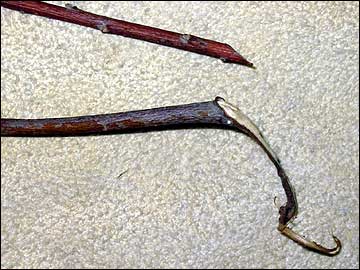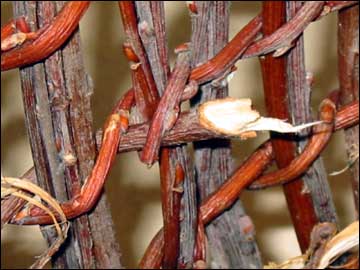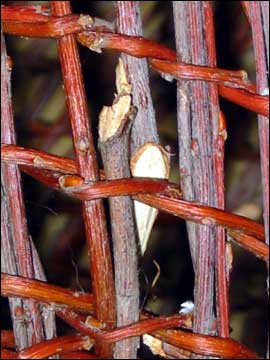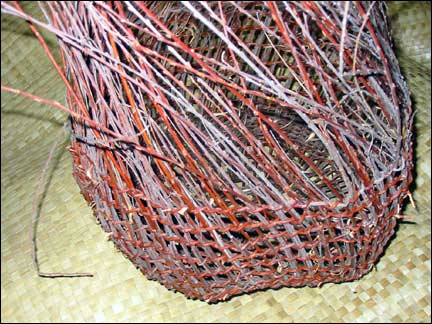
Back in the Bulletin of Primitive Technology issue #21 (pg 37), Alice Tulloch posed a lithic challenge. Her "Figure 2" showed twiner sized stems harvested by pulling them from the main stem of willow or redbud. These showed a characteristic lump where they were torn from the branch (and a tail of bark). Her challenge had to do with harvesting material too large to break off this way, but too small in diameter to cut with a stone saw or axe efficiently. Solutions to her challenge were offered by myself in the Bulletin of Primitive Technology #22 and by Goode Jones in the Bulletin of Primitive Technology #23. The image of the pulled off stems with their lumpy ends stayed with me.

The technique I had learned for adding in whole shoot twiners seemed to have been created with those end lumps in mind - you wrap the tapering end of the spent twiner around the large end of the replacement. Cut ends have minimal taper and pull out easily until worked in to the pattern. A technique for adding ribs into close twined Paiute baskets involved fattening the base of the rib by chewing on it, thus making it more secure. Both of these techniques were suggestive that they had originated with pulled off stems.
As I am always looking to find the most basic and efficient way to do skills, and having tried harvesting with stone flakes, I decided this winter to explore basketry using no tools other than my hands - bare-handed basketry. I had three areas of interest: relative speed and efficiency of harvest; relative ease and strength as twiners; relative ease and strength as ribs.
HARVESTING
When harvesting whole shoot willow with a knife, flake or pruners,
I have long been bothered by finding I needed three hands to be
efficient - one to hold the willow tree, one to hold the tool
and one to hold the cut shoots. Without the tool, I had only to
hold and pull off shoots until my hand was full. I found it worked
best to start at the top of the main stem and work downward. My
speed of gathering seemed to be much faster than with tools (I'll
need to run several time trials to determine this with accuracy).
The down side was that I was limited in what I could collect this
way, as end growth and growth beyond a stem gall could not be
easily harvested by hand. There was also the matter of wear and
tear on my hand, but practice reduced this to a minimum (speed
and angle of pull). The final part of my harvesting cycle involves
copicing (cutting back) the willow plants to promote better new
growth. Historical records indicate this was done by burning (see
Tulloch, Bulletin of Primitive Technology #21). As burning
is not an option where I collect, I will have to continue to use
metal tools to accomplish this task.
USE AS TWINERS
As I imagined, using my hand harvested twiners made great sense
given the method I use to add them in. Indeed, they are nearly
impossible to pull out, unlike cut shoots. One disadvantage I
did find was that some of the stems tapered at the base to a diameter
which was a bit too thick, but if not too severe, I could still
use them by inserting them deeper into the piece. This left more
pieces to snag things on the inside of the basket, and the lumpy
ends also made a coarser inside texture, but as these baskets
are for coarse work, such as collecting firewood and acorns, this
did not seem to be a significant drawback. This also gets back
to the harvesting of only ideal material, requiring a large resource
base as would have been available in pre-historic times.

USE AS RIBS
The technique for adding ribs into a coarse twined basket was
sufficiently variable to accommodate the pull harvested shoots
by extending them on the inside of the basket past one row of
twining. The same limitations applied concerning the selection
of ideal size material unless trimming were to be done. Trimming
would also be required to use the add in method of inserting the
new ribs into the work by paralleling an existing rib, a technique
which produces a smoother appearance.

CONCLUSIONS
Basketry with hands only collected and prepared materials seems
quick and efficient as long as there is no shortage of material
from which to harvest. Some add in techniques found in western
North America suggest that they originated with hand harvested
material. Hand harvesting is much faster and easier than harvesting
with stone flakes, either hand held or hafted. Once harvested
the material could be trimmed if necessary for a particular type
basket whether hand or blade harvested.

On the personal side, I found the same feeling of primal connection creating a basket with no tools as I had the first time I made fire in the field from collected sticks and simple stone tools. This sense of freedom from technology, replacing dependence on gear with dependence on the environment and your own knowledge and skill seems to be as close as we can come to experiencing our ancestors sense of self. I also plan to continue using hand harvesting if for no other reason than it's faster (although I'll still have my pruners handy).
E-mail your comments to "Norm Kidder " at atlatl1@aol.com
We hope the information on the PrimitiveWays website is both instructional and enjoyable. Understand that no warranty or guarantee is included. We expect adults to act responsibly and children to be supervised by a responsible adult. If you use the information on this site to create your own projects or if you try techniques described on PrimitiveWays, behave in accordance with applicable laws, and think about the sustainability of natural resources. Using tools or techniques described on PrimitiveWays can be dangerous with exposure to heavy, sharp or pointed objects, fire, stone tools and hazards present in outdoor settings. Without proper care and caution, or if done incorrectly, there is a risk of property damage, personal injury or even death. So, be advised: Anyone using any information provided on the PrimitiveWays website assumes responsibility for using proper care and caution to protect property, the life, health and safety of himself or herself and all others. He or she expressly assumes all risk of harm or damage to all persons or property proximately caused by the use of this information.
© PrimitiveWays 2014